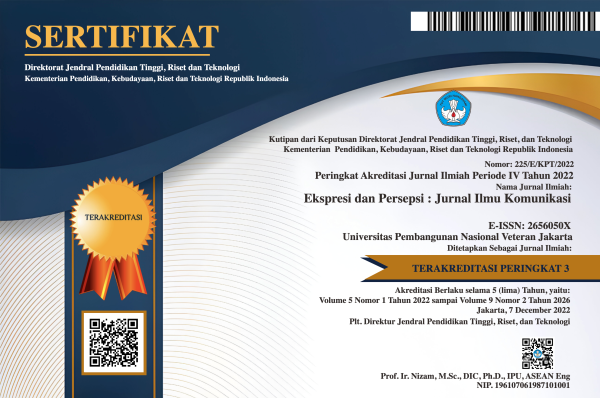KOMODIFIKASI KONTEN ASING DAN LOKAL OMETV PADA KANAL YOUTUBE
DOI:
https://doi.org/10.33822/jep.v6i2.5625Keywords:
content commodification, YouTube, OmeTV, social media, media and communicationAbstract
This research reviews YouTube content creators who take advantage of interactions with foreigners on the OmeTV platform in Indonesia. Researchers focus on the production and distribution of foreign and local content through the phenomenon of casual conversation as a form of capitalization. Previous researchers had the limitation that social media studies were subject to commodification (Fuchs, 2014b, 2019). In this study, researchers consider that content creators play an important role in commodifying content because YouTube is a channel that facilitates the formation of popularity. This assumption is based on the argument that playlabor is voluntary while seeking pleasure in the social media space (Fuchs, 2014a). This text revived media production by linking it to cultural studies (Hesmondhalgh & Toynbee, 2008). This research aims to explain how content creators as well as OmeTV players commodify foreign and local content to gain economic benefits. Researchers used the method of content analysis and phenomenology. Content analysis aims to identify forms of content, while phenomenology is to explain the process of commodification and production relations between the OmeTV and YouTube platforms. The results of this study reveal that the commodification of foreign and local content with the seduction genre has become popular content that benefits YouTubers. In reproducing content, OmeTV players prepare verbal and nonverbal seduction communication strategies
References
Abidin, C. (2016). Please Subscribe! Influencers, Social Media, and the Commodification of Everyday Life. Ph. D Thesis.
Abidin, C. (2022). Grief hypejacking: Influencers, #ThoughtsAndPrayers, and the commodification of grief on Instagram. Information Society, 38(3), 174–187. https://doi.org/10.1080/01972243.2022.2071212
Atay, Ahmet & D’Silva, M. U. (2019). Mediated Intercultural Communication in Digital Age. Routledge.
Couldry, N. (2004a). Liveness, “reality,” and the mediated habitus from television to the mobile phone. Communication Review, 7(4), 353–361. https://doi.org/10.1080/10714420490886952
Couldry, N. (2004b). Theorising media as practice. Social Semiotics, 14(2), 115–132. https://doi.org/10.1080/1035033042000238295
Creswell, John W & Poth, Cheryl, N. (2018). Qualitative Inquiry & Research Design, Choosing Among Five Approaches 4th Edition. SAGE Publication.
Denzin, Norman; Lincoln, Y. S. (2019). The handbook on Qualitative Research. In Sage Publications (Vol. 5). https://doi.org/10.1017/CBO9781107415324.004
Dewi, A. P., & Delliana, S. (2020). Self Disclosure Generasi Z Di Twitter. Ekspresi Dan Persepsi : Jurnal Ilmu Komunikasi, 3(1), 62. https://doi.org/10.33822/jep.v3i1.1526
Faizal, D. (2022). Trend Ome TV Di Kalangan Remaja Sebagai Sarana Komunikasi Untuk Menjalin Pertemanan Asing. http://repository.uir.ac.id/id/eprint/13985%0Ahttps://repository.uir.ac.id/13985/1/189110138.pdf
Featherstone, M. (2007). Consumer culture and postmodernism. In Consumer Culture and Postmodernism. https://doi.org/10.4135/9781446212424
Fuchs, C. (2012). Dallas Smythe Today - The Audience Commodity, the Digital Labour Debate, Marxist Political Econoomy and Critical Theory. Prolegomena to a Digital Labour Theory of Value. 10(2), 692–740.
Fuchs, C. (2014a). Digital labour And Karl Marx. Routledge. https://doi.org/10.4324/9781315768656-4
Fuchs, C. (2014b). Digital prosumption labour on social media in the context of the capitalist regime of time. Time & Society, 23(1), 97–123. https://doi.org/10.1177/0961463X13502117
Fuchs, C. (2015). Reading Marx in the Information Age. In Reading Marx in the Information Age. https://doi.org/10.4324/9781315669564
Fuchs, C. (2019). Rereading Marx in the Age of Digital Capitalism. Pluto Press.
Fuchs, C. (2022). Digital Capitalism: Media, Communication and Society Volume Three. In Digital Capitalism: Media, Communication and Society Volume Three. Routledge. https://doi.org/10.4324/9781003222149
Glatt, Z. (2017). The Commodification of YouTube Vloggers. 3329087101.
Hesmondhalgh, D., & Toynbee, J. (2008). The media and social theory. In The Media and Social Theory. https://doi.org/10.4324/9780203930472
Jenkins, R. (1992). Pierre Bourdieu: Key Sociologists. In Routledge: London Kaugitçibacsi, Ç.(1982).Sex Roles And Value of Children and Fertility In Turkey In Sex Roles, Family, and Community In Turkey Kaugitçibacsi, Ç.(ed), Indiana University. Turkish Studies (Vol. 3). Routledge. file:///Users/jeltsjestobbe/Documents/SENTE VERSIES/LITERATUUR PROMOTIETIJD.sente6lib/Contents/Attachments/Jenkins/1992/Key Sociologists_ Pierre Bourdieu/Jenkins 1992 Key Sociologists Pierre Bourdieu.pdf
Kemp, S. (2023). Digital 2023 : Global Overview Report. Datareportal.
Khansa, S. D., & Putri, K. Y. S. (2022). Pengaruh Sosial Media Tiktok Terhadap Gaya Hidup Remaja. Ekspresi Dan Persepsi : Jurnal Ilmu Komunikasi, 5(1), 133. https://doi.org/10.33822/jep.v5i1.3939
Krippendorff, K. (2019). Content Analysis An Introduction to Its Methodology Fourth Edition Content Analysis.
Martianto, R. W. U., & Toni, A. (2021). Analisis Semiotika Gaya Komunikasi Milenial Bambang Soesatyo Melalui Youtube Podcast. Ekspresi Dan Persepsi : Jurnal Ilmu Komunikasi, 4(1), 13–28. https://doi.org/10.33822/jep.v4i1.2351
Marx, K. (1904). A Contribution to the Critique of Political Economy (2010).pdf (p. 314).
Mattoni, A., & Couldry, N. (2012). Book Reviews 951. 951–953.
Mosco, V. (2009). The Political Economy of Communication. In The Political Economy of Communication. SAGE Publication. https://doi.org/10.4135/9781446279946.n5
Naki, F. (2023a). Contoh Konten Merayu Gombal di YouTube. https://www.youtube.com/watch?v=gcBeEsShfxY&t=302s)
Naki, F. (2023b). Tampilan Konten Lokal dan Asing OmeTv di YouTube. https://www.youtube.com/@fikinaki4647/videos
OmeTv. (2023). Tampilan OmeTv.
Perry, N. (2012). Hyperreality and global culture. In Hyperreality and Global Culture. https://doi.org/10.4324/9780203019375
Raun, T. (2018). Capitalizing intimacy: New subcultural forms of micro-celebrity strategies and affective labour on YouTube. Convergence, 24(1), 99–113. https://doi.org/10.1177/1354856517736983
Sinaga, Y. K., Sinurat, B., Saragih, D. Y., & Saputra, N. (2022). An Analysis of Positive and Negative Politeness Strategy in Ome TV by Fiki Naki on Youtube. LingLit Journal Scientific Journal for Linguistics and Literature, 3(2), 93–102. https://doi.org/10.33258/linglit.v3i2.725
Sum, N. L., & Jessop, B. (2013). Towards a Cultural Political Economy: Putting Culture in its Place in Political Economy. In Towards a Cultural Political Economy: Putting Culture in its Place in Political Economy. https://doi.org/10.4337/9780857930712
Thurlow, C., Lengel, L., & Tomic, A. (2004). Computer Mediated Communication (Social Interaction and The Internet). Sage Publication.
Ulya, H., Nurdianingsih, F., & Matin, F. (2021). The influence of ome tv toward students speaking skill. 2–5.
Warde, A. (2002). Construction of Pierre Bourdieu. Sage Journals, 36(4), 1003–1009. https://doi.org/https://doi.org/10.1177%2F003803850203600411
Warde, A. (2014). After taste: Culture, consumption and theories of practice. Journal of Consumer Culture, 14(3), 279–303. https://doi.org/10.1177/1469540514547828
Yonan. (2021). Optimalisasi Penggunaan Media Video Call OME TV. Seminar Nasional Bahasa Arab Mahasiswa V Tahun 2021, 389–398.
Downloads
Published
Issue
Section
License
Copyright (c) 2023 Maria Febiana Christanti, Puri Bestari Mardani

This work is licensed under a Creative Commons Attribution-NonCommercial 4.0 International License.














